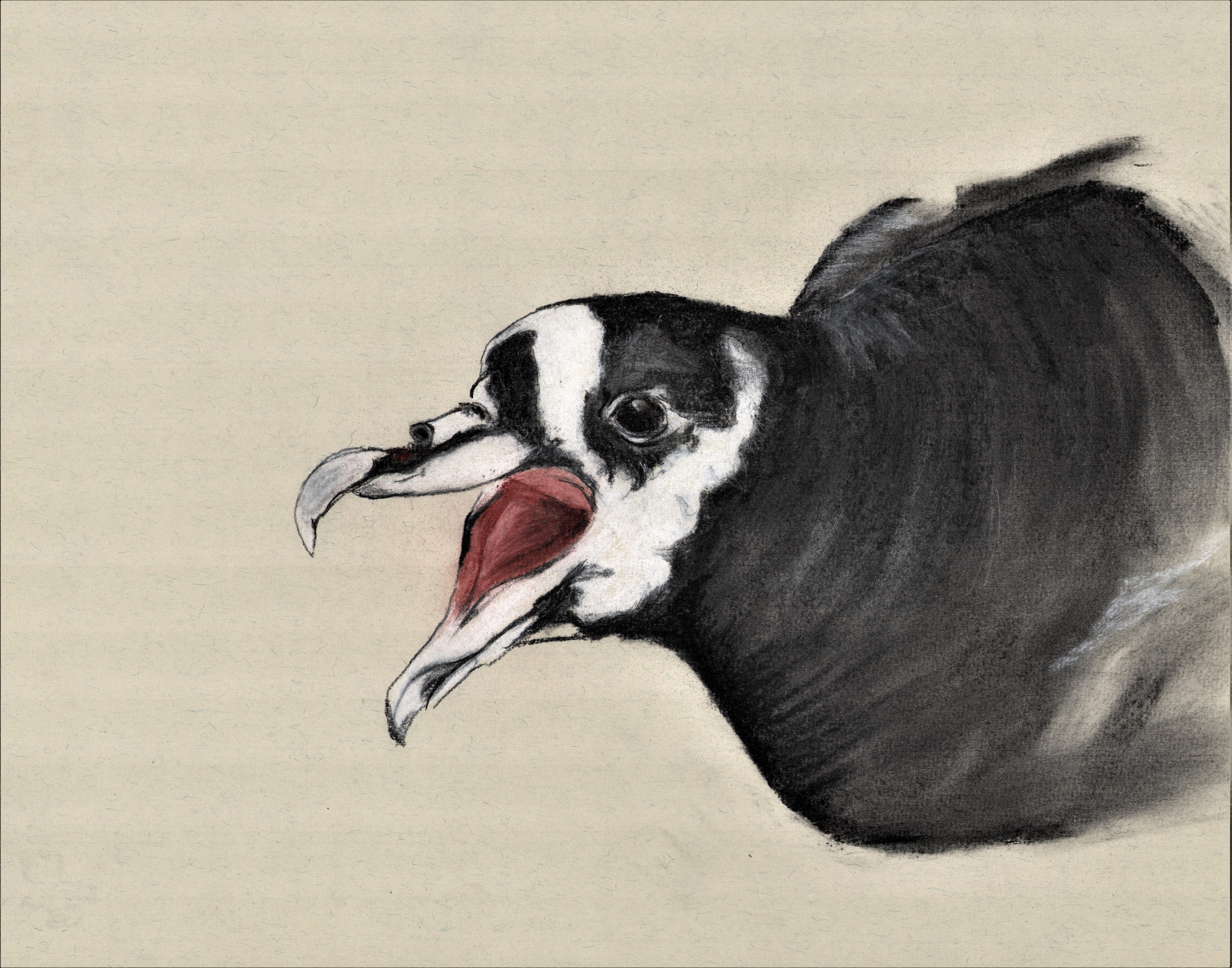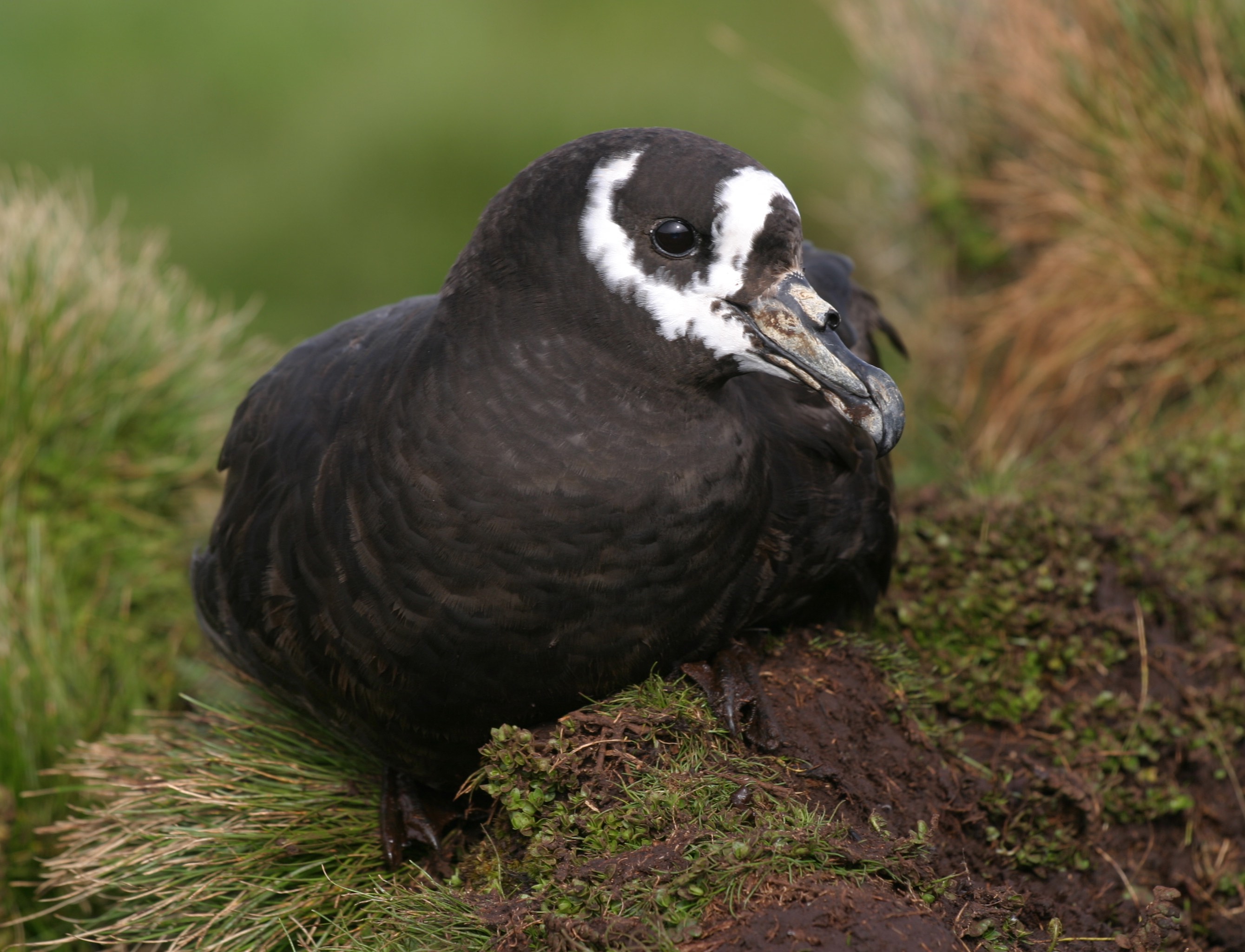
Spectacled Petrel by Lea Finke of ABUN for ACAP, charcoal, chalk and sanguine; after a photograph by Peter Ryan
Note: The illustrated Species Summaries have been written to help inform the genera public, including school learners, of the biology and conservation needs of the 31 ACAP-listed species. They serve to complement the more detailed and referenced ACAP Species Assessments. To date, summaries for the 22 species of albatrosses have been produced in in all three ACAP official languages, English, French and Spanish.
Texts have also been prepared for the nine ACAP-listed petrels and shearwaters in English, but as yet have not been translated into French and Spanish. As an interim service, the illustrated English texts are being posted to ACAP Latest News, continuing here with the Spectacled Petrel Procellaria conspicillata.

Spectacled Petrel on Inaccessible Island; photograph by Peter Ryan
The Spectacled Petrel is one of five medium-to-large petrels within the genus Procellaria, along with the Black, Grey, Westland and White-chinned. Among all the petrels and shearwaters in the family Procellariidae, they are the largest that dig and breed in burrows.
The species is essentially all dark brown to black save for conspicuous white markings on the head, giving the bird its name, as well as its local name of ‘Ringeye’. The bill is yellowish but with a darker tip than its close relative, the White-chinned Petrel. Spectacled Petrels breed only on the plateau of uninhabited Inaccessible Island (12.65 km²), part of the United Kingdom Overseas Territory of St Helena, Ascension and Tristan da Cunha in the South Atlantic. It may have bred on Amsterdam Island in the southern Indian Ocean in the past, but like several other species, was extirpated there following the introduction of several mammals to the island. The petrel’s current at-sea distribution is largely confined to the South Atlantic with birds regularly reaching the continental waters of Brazil and southern Africa, although the few records in the southern Indian Ocean extend to Australia.
The most recent survey of numbers on Inaccessible Island, made in 2018, resulted in an estimate of 30 000 breeding pairs, reflecting a steady increase since at least the 1930s following the disappearance of introduced pigs. The species breeds in burrows in wet heath, bogfern heath and locally in Phylica woodland from 250 to 500 m above sea level, laying a single white egg and rearing the single chick through the austral summer. Diet is primarily squid, as well as crustaceans and fish, taken from the sea surface or by shallow dives.
Past threats included feral pigs on Inaccessible, extirpated in the early 20th century; the island is now free of introduced mammals. Currently, birds are killed by longline fisheries, notably of the coast of Brazil, but not at a rate to halt the ongoing population increase. Despite this, the Spectacled Petrel’s single breeding site means it retains a conservation category of Vulnerable. Introduction of rodents (present on the inhabited island of Tristan da Cunha 37 km away) remains a potential threat that needs to be continuously guarded against from landings, fishing vessels and shipwrecks. Adoption of ‘best practice’ mitigation measures by longline fisheries in both national and international waters, including deployment of bird-scaring lines, line weighting and night setting, will reduce at-sea mortalities.
Inaccessible Island and its territorial waters are a nature reserve declared by the Tristan da Cunha Government in 1997, a Ramsar Wetland of International Importance (from 2008), and with Gough Island a natural World Heritage Site since 2004. Both islands have a combined management plan which controls landings by researchers and tourists. In 2021 a Marine Protected Area extending to the edge of the 200-nautical mile Exclusive Economic Zone is due to be formally declared around Inaccessible and the other islands of the Tristan-Gough group.
Sources:
ACAP 2012. Spectacled Petrel Procellaria conspicillata.
BirdLife International 2021. Species factsheet: Procellaria conspicillata.
Ryan, P.G., Dilley, B.J. & Ronconi, R.A. 2019. Population trends of Spectacled Petrels Procellaria conspicillata and other seabirds at Inaccessible Island. Marine Ornithology 47: 257-265.
John Cooper, ACAP Information Officer, 23 March 2022

 English
English  Français
Français  Español
Español